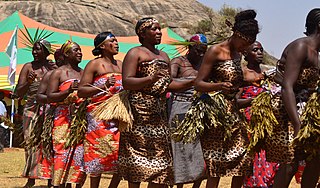
The Chadic languages form a branch of the Afroasiatic language family. They are spoken in parts of the Sahel. They include 196 languages spoken across northern Nigeria, southern Niger, southern Chad, and northern Cameroon. By far the most widely spoken Chadic language is Hausa, a lingua franca of much of inland Eastern West Africa, particularly Niger and the northern half of Nigeria.

There are over 525 native languages spoken in Nigeria. The official language and most widely spoken lingua franca is English, which was the language of Colonial Nigeria. Nigerian Pidgin – an English-based creole – is spoken by over 60 million people.
Bade is a West Chadic language spoken by the Bade people in Yobe State and Jigawa State, Nigeria. Their traditional ruler is the Emir of Bade. Similar to many other Western African languages, Bade is a vulnerable language at great risk of extinction. With 356,000 speakers, the language and the culture of the Bade people have suffered over the last several years. As the language continues to fade, the culture and historic value associated with the language perishes as well. The local dialect is shifting from Bade to Hausa. Across West Africa, the impact on local communities through the loss of the indigenous tongues will be significant. The endangerment of the Bade language represents the worldwide language diversity that is at risk. Many African languages have only received little linguistic attention, impacting these African languages.

Ngas, or Angas, is an Afro-Asiatic language spoken in Plateau State, Nigeria. The language has two dialects: Hill Angas and Plain Angas. Ngas language is one of the major languages in Plateau State, the 1952 census puts it as the largest ethnic group in Plateau State. Retired General Yakubu Gowon is a prominent Nigerian who is of Ngas extraction.
Koenoem is an Afro-Asiatic language spoken in Plateau State, Nigeria. It is spoken in about 6 villages east of the Panyam-Shendam road.
Tal is an Afro-Asiatic language spoken in Plateau State, Nigeria. Tal is spoken in a cluster of 53 villages located east of the Panyam-Shendam road. There are 6 dialects of Tal, namely Bongmuut, Buzuk, Nbaal, Muɗak, Muɗong, and Takong.

The Angas, Angas–Sura, or Central West Chadic languages are a branch of West Chadic languages spoken in Plateau State, north-central Nigeria.
Warji (Warjawa) or Sirzakwai is an Afro-Asiatic language spoken in Bauchi State, Nigeria. Speakers are shifting to Hausa.

The North Bauchi languages are a branch of West Chadic languages that are spoken in Bauchi State, northern Nigeria.

The Bole–Tangale languages are a branch of West Chadic languages that are spoken in various states of northeastern Nigeria.
Bure, also known as Bubbure, is an Afro-Asiatic language belonging to the Bole-Tangale group of the West branch of the Chadic family. It is spoken in northern Nigeria in the village of Bure and in some small settlements nearby. The language is used mostly by a very few speakers, of great-grandparental generation. Except for Hausa, which is lingua franca in the area, Bure is surrounded by other Chadic languages such as Gera, Giiwo and Deno.

Karai-karai is a language spoken in West Africa, most prominently North eastern Nigeria. The number of speakers of Karai-karai is estimated between 1,500,000 to 1,800,000 million, primarily spoken by the ethnic Karai-Karai people. It is an Afro-Asiatic language spoken principally in Nigeria with communities in Bauchi State, Yobe State, Gombe State and other parts of Nigeria. Many Karai-karai words share a common origin with the Northwest Semitic languages of Hebrew and Arabic. The Karai-karai language is most closely related to the Ngamo and Bole languages which are both considered derivatives of the Karai-karai language.

The South Bauchi languages are a branch of West Chadic languages that are spoken in Bauchi State and Plateau State, Nigeria.
Mantsi is an endangered Afro-Asiatic language spoken in Mangas town in Bauchi State, Nigeria. Blench (2020) reports that it is also called Mantsi. According to Blench, the structure of Mantsi differs significantly from the other South Bauchi languages.

Ron is an Afro-Asiatic language cluster spoken in Plateau State, Nigeria. Dialects include Bokkos, Daffo-Mbar-Butura, Monguna/Manguna (Shagau),. Blench (2006) considers these to be separate languages.
Daza or Dazawa is listed by Blench (2006) as a Chadic language within the Bole group, spoken in a few villages of Darazo LGA, Bauchi State, Nigeria. It was confirmed to exist in 2021. The language is nearly extinct with only elderly speakers speaking the language. Native speakers have shifted to Hausa.
Polci is an Afro-Asiatic language of Bauchi State, Nigeria. It is part of the Barawa cluster, which is in turn part of the West Chadic language family.
Ju is a language from the West Chadian branch of the Chadic language family. The language is spoken solely in Nigeria, and had approximately 900 native speakers in 1993. The language is unwritten.
Tala is a language from the West Chadian branch of the Chadic language family. The language is spoken in the central regions of Nigeria, and had approximately 1000 native speakers in 1993. The language is unwritten.

The Hausa–Gwandara languages of the Afro-Asiatic family are spoken principally in Niger and Nigeria. They include Gwandara and Hausa, the most populous Chadic language and a major language of West Africa.








